Languid charms of Myanmar
Cut off from the rest of the world by its isolationist military junta for several decades, Myanmar has attracted considerable attention in recent times as an exotic tourism destination whose glittering pagodas have earned it the descriptive of the Golden Land

Although it’s in the news for all the wrong reasons, our neighbour nation Myanmar aka Burma (pop. 54.8 million) is perhaps the most pristine, unexplored country of the contemporary world — the last Shangri-la. Sited at the junction where Asia’s two great civilizations — India and China — meet, Myanmar stretches from the Cocos Island in the south, up into the Eastern Himalayan Mountain range. It ranks among South-east Asia’s largest (area: 676,500 sq km) and most culturally diverse countries.
Although a military dictatorship, Myanmar is a safe country for tourists. Boasting perhaps the lowest tourist crime record worldwide, Myanmar’s military junta has ambitious plans to modernise and improve the tourism infrastructure to attract international tourists.
After a two-year lockdown owing to the Covid-19 pandemic, Myanmar reopened to international tourists on April 17.
Just as well because Myanmar is a treasure trove of attractions. Languid and peaceful, the country offers sandy unpolluted beaches, tropical natural beauty, snow-capped mountains, a tranquil Buddhist culture and splendid architecture. Moreover, the Buddhist traits of serenity and gentleness are quite evident in its people, who go about their business with thanaka paste (ground bark paste similar to sandalwood) daubed on their high cheek bones to guard against the blistering sun. This is a curious sight for first time visitors.
Myanmar’s rich and glorious history spanning two thousand years is evident in its spectacular monuments and ancient cities. Modern-day Myanmar is home to 135 uniquely different ethnic groups. The country’s seven administratively convenient ethnic divisions (tain) are: Ayeyarwady (Irrawaddy), Bago (Pegu), Magway (Mandalay), Yangon (Rangoon), Sagaing, and Tanintharyi (Tenassarim). These are the admin capitals of the seven ethnic (pyi nay): Chin, Kachin, Kayin (Karen), Kayah (Karenni), Mon, Rakhine (Arakan) and Shan people.
Topographically as well, the country is diverse with its central lowlands circled by steep, rugged highlands. As in most of South-east Asia, the cool season extends from October through February with mean temperatures averaging 20-240C; the hot season, from March through May when the mercury rises to 30-350 C; and finally, the monsoon, from June through September when mean temperatures drop to 25-300C.
Richly endowed with natural resources such as gas and petroleum, timber, tin, zinc, copper, tungsten, lead, coal and limestone, and globally renowned as a major source of imperial jade and pigeon blood rubies, Myanmar is primarily an agricultural country with 50 percent of its GDP derived from agriculture, livestock, fisheries, and forestry. Manufacturing/industry contributes only 15 percent of GDP and is strictly controlled by the military junta. In recent years, export of natural gas to Thailand has also become one of the main sources of revenue.
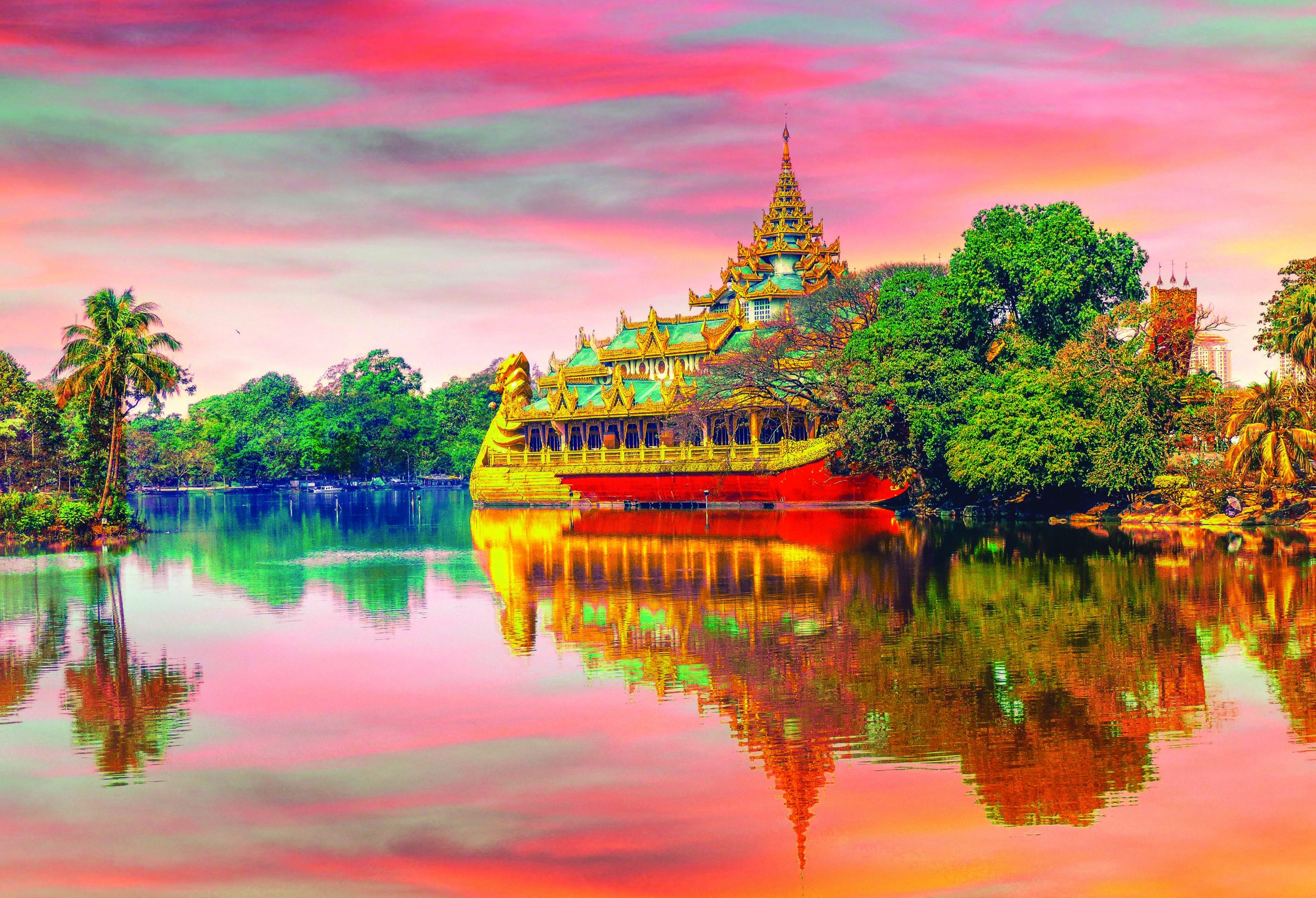
Yangon
Cut off from the rest of the world by its isolationist military junta for several decades, Myanmar has attracted much attention in recent times as an exotic tourism destination, whose glittering pagodas have earned it the descriptive of The Golden Land. Much of this mountainous country is covered by dense forest abounding in wildlife. Snow-capped peaks in the north and the Ayeyarwady river that serves as the riverine artery of Myanmar, offer exploratory opportunities even as its ancient Buddhist culture and monuments have transformed the country into one of the richest archaeological regions of South-east Asia.
Inevitably, this ancient country has an interesting history. On several occasions it was fragmented, but unified three times. The first unification was during the reign of the Bagan (Pagan) dynasty in 1044 AD, known as the Golden Age in Burmese history. Theravada Buddhism was introduced in Burma during this time, and the Bagan kings built a massive city with thousands of pagodas and monasteries along the Ayeyarwady river. The Bagan dynasty ruled until 1287 when Mongol invaders destroyed the kingdom.
Later, from 1486 to 1752 the Taungoo dynasty acceded to power, but there was little cultural development during this period because the rulers were constantly involved in internal power struggles and warfare. However, during their reign Burma was unified as a large, multi-ethnic kingdom.
The Konbaung royal dynasty established its sway over Burma in the second half of the 18th century under the rule of King Alaungpaya. Following in the footsteps of the Taungoo kings, the Konbaung rulers also waged wars with the ethnic Mons, Arakanese and Siamese. This period also witnessed four invasions by the Chinese and three devastating wars with the British who were establishing themselves in neighbouring India. At the end of the third war in 1885, the British acquired complete control of Burma, annexing it with India.
When World War II broke out in 1939, Burmese nationalists led by General Aung San joined with Japanese forces moving westward after taking Singapore in 1942, in a vain bid to drive out the British. After the war General Aung San demanded complete political and economic independence from Britain. A constitution was formulated in 1947 and independence was won in January 1948, although General Aung San and most of his cabinet members were assassinated before the constitution became effective.
After acquiring independence, Burma transformed into the Union of Burma with U Nu as its first prime minister. But democratic rule ended in 1962 following a military coup led by General Ne Win who ruled for nearly 26 years. In 1988, student-led disturbances broke out in Rangoon (Yangon). At a rally, military forces massacred more than 1,000 demonstrators. Aung San Suu Kyi, daughter of General Aung San, emerged as the leader of the pro-democracy forces. In September 1988, the army deposed Ne Win’s Burmese Socialist Program Party, suspended the constitution, and established a new ruling junta called the State Law and Order Restoration Council (SLORC). In 1989, Burma was renamed the Union of Myanmar.
In 1990, for the first time after independence, free elections were held resulting in a landslide victory of NLD (National League for Democracy), a party led by Aung San Suu Kyi. But the ruling junta refused to respect the electoral verdict. It placed Suu Kyi under house arrest and under a new nomenclature — State Peace and Development Council (SPDC) — continued to rule the country with an iron hand. However in the 2015 general elections, Suu Kyi’s party won a landslide victory again and she assumed the newly created role of State Counsellor of Myanmar, akin to prime minister. However, during her brief term, Suu Kyi drew criticism from several countries over Myanmar’s inaction to the genocide of the Rohingya people.
Suu Kyi, whose party again won the November 2020 general election, was arrested on February 1, 2021 following a coup d’état that returned the junta to power.
Myanmar’s native population is primarily ethnic Burmans (70 percent), with other tribes such as Shans, Karens, Rohingya, Arakanese, Kachins, Chins, Mons, and smaller ethnic groups comprising the rest. Indians and Chinese are the largest non-indigenous groups in the country. Although Burmese is the most widely spoken language, other ethnic groups have retained their identities and languages. English is spoken in the few cities that tourists are allowed to visit.
Yangon
Also known as Rangoon, the former capital of Myanmar, clean and green Yangon (pop.5.5 million) is known as the Garden City of the East. Its magnificent Buddhist temples, open-air markets, parks and serene lakes are focal points for tourists. Located in the fertile delta area of southern Myanmar on the banks of the River Yangon about 30 km inland from the coast, it is one of the most charming cities in Asia. There are vestiges of colonial grandeur in its wide avenues and decrepit period bungalows, with the teak paneled Strand Hotel evoking the setting of a Somerset Maugham novel. Contemporary Yangon spans 598 sq km, strewn with ancient pagodas and modern shopping complexes.

Yangon river
The main attraction here are revered Buddhist shrines including the 2,500-year-old Shwedagon Pagoda in midtown Yangon, between the People’s Park and Kandawgyi Lake. On full moon nights, mystical chanting, heady incense and flickering candles create a magical aura. Also worth visiting is the nearby Sule Pagoda, renowned for its tall chedi (stupa). Estimated to be over 2,000 years old, the monument has been restored and is well maintained, because the central stupa is believed to enshrine a lock of the Buddha’s hair. Another must-visit monument in Yangon is the Chauk-tat-gyi Pagoda, originally built in 1907, restored in 1966, enshrining a 70-metre long reclining Buddha.
A visit to the National Museum, housed in five floors of a large modern building is also recommended to learn about the history and culture of Myanmar. The main floor showcases the magnificent eight metres tall Lion Throne of King Thibaw Min, the last king of Burma (1859-1916). Other exhibits include the Mandalay Regalia, a collection of gem-studded arms, swords and jewellery, and works of art of Myanmar’s most renowned modern painters.
Other tourist attractions in Yangon include the Nga-tat-gyi Pagoda, Lawka Chantha Abhaya Labbha Muni Buddha Image, Kaba Aye (World Peace) Pagoda and Mahawizaya Pagoda. The residence of pro-democracy leader Aung San Suu Kyi can be viewed from a distance. Almost every visitor to the Burmese capital gazes reverentially at the house where the country’s most heroic figure resides in enforced silence.
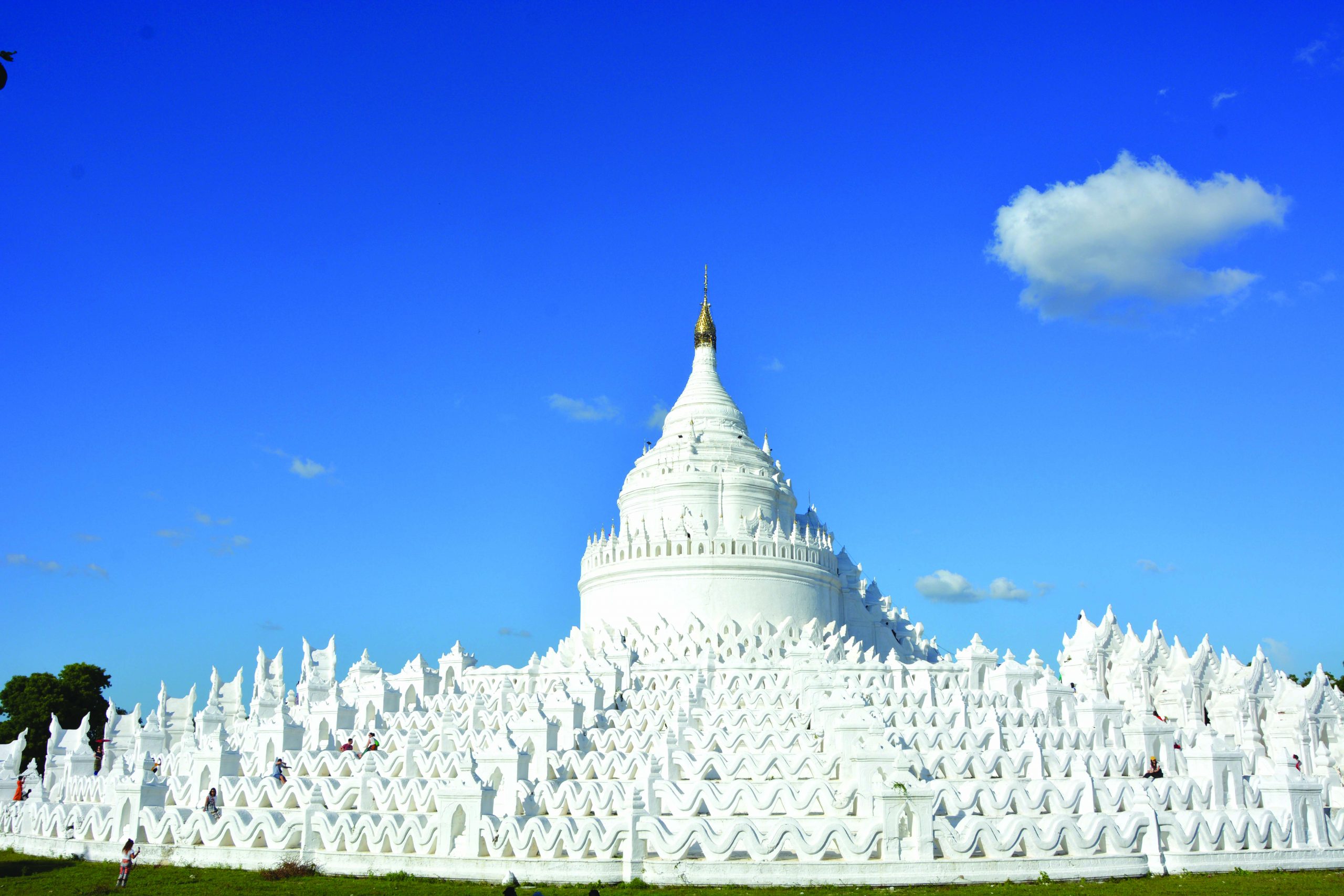
Hsinbyume pagoda, Min Kun
Excursions ex Yangon. Several excursion options are available to modestly adventurous travellers. Sited 11 km north of Yangon is the 34 metre high Kaba Aye (‘World Peace’) Pagoda, built in 1952 to welcome delegates to the Sixth Buddhist Synod (1954). For visitors keen to take a break from viewing temples and monuments, the Hlawga Wildlife Park (35 km), which stretches across 1,650 acres and hosts over 70 species of herbivorous animals and 90 avian species, is a refreshing option. Elephant rides and fishing facilities are available.
Shopping. Yangon is an affordable destination for alternative shopping. The covered 70-year-old Bogyoke Market aka Scott Market is a cornucopia of Burmese handicrafts, textiles, gems and jewellery, lacquerware and Shan shoulder bags, T-shirts and cheroots.
Accommodation. Myanmar’s tourism infrastructure offers a wide range of hotels, from five-star hostelries to guesthouses in all major cities, as also upscale mountain and beach resorts. Yangon is the base point for most expeditions and hosts a major chunk of the hotel accommodation available.
Top-end: Sedona Hotel Yangon (Rs.8,400 per night), Awei Metta Yangon (Rs.8,974), Avenue 64 Hotel (Rs.9,513). Mid-range: Inya Lake Hotel (Rs.4,744), Best Western Green Hill Hotel (Rs.5,938), Parkroyal Yangon (Rs.4,766). Budget: Prestige Residences at Golden Valley by Grand United Hospitality (Rs.2,652), Hotel Parami (Rs.2,159), Hotel 63 (Rs.1,781).
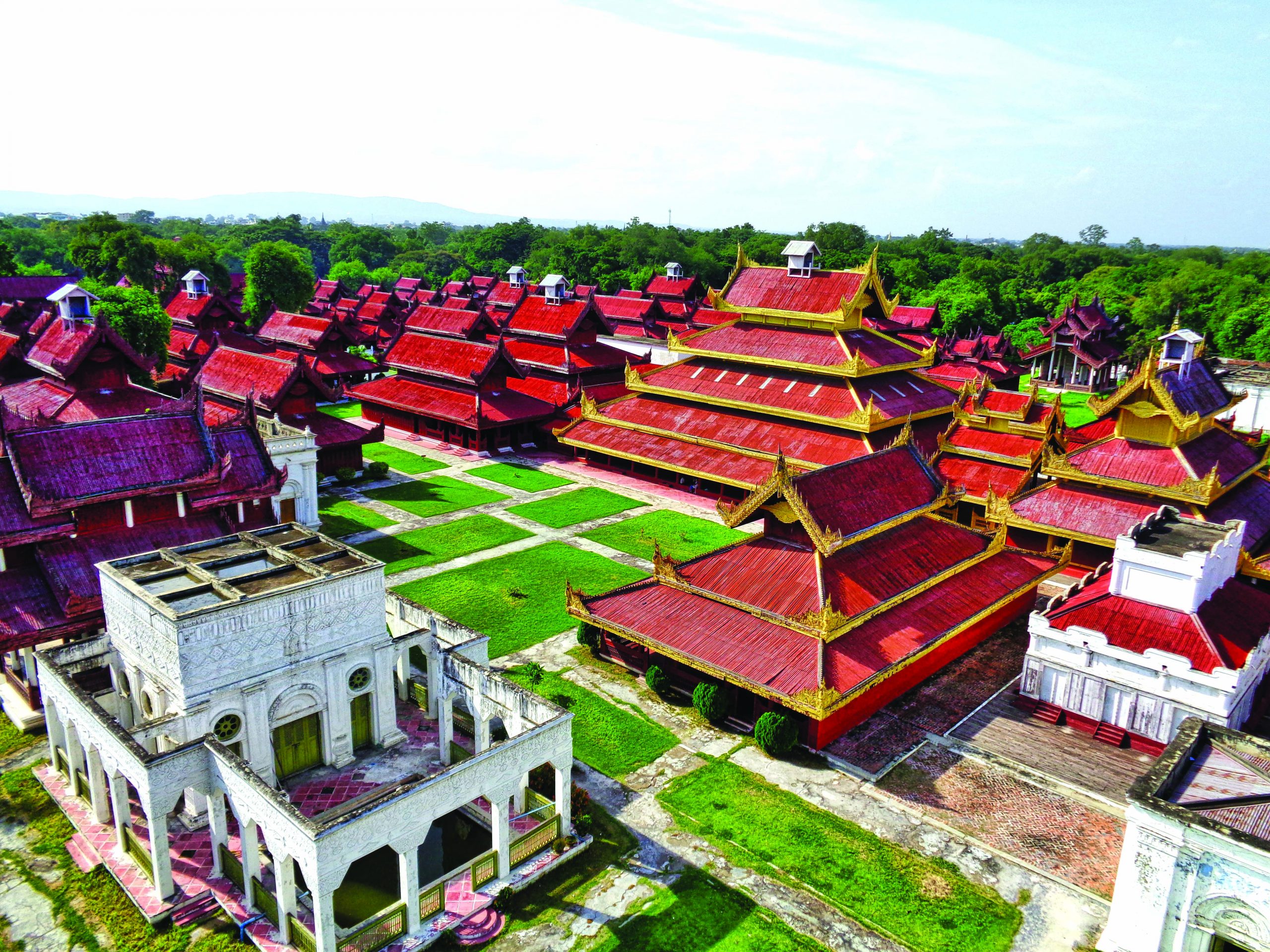
Mandalay
The capital of Burma until the British took charge of the country in 1885, Mandalay (pop. 1.5 million) is Myanmar’s second largest city. About 627 km from Yangon, it is a bustling commercial hub and the repository of Myanmar’s cultural heritage. With its ancient monasteries, Mandalay is a showcase of 19th century native art and architecture in particular. The city boasts a large population of traditional artisans who carve exquisite handicrafts out of wood, stone and precious metals. Embroidery and lacquerware are old and popular crafts of this region.
While in Mandalay visit the Shwenandaw Kyaung, an extant remnant of a once extravagant royal palace. Mandalay Hill with its spiralling stairways, temples and the ancient Rakhine Buddha image at Mahamuni Paya is definitely worth a visit. A short excursion away are ruins of the abandoned cities of Amarapura, Sagaing, Ava and Mingun, each with a rich archaeological history. Mingun is accessible only by river and the boat ride from Mandalay offers scenic rural vistas. Its unfinished pagoda claims to have the largest ringing bronze bell in the world.
Accommodation. Top-end: Hotel Pyin Oo Lwin (Rs.7,047 per night), The View Resort and Restaurant
(Rs.14,681), Mandalay Lodge Hotel (Rs.7,013). Mid-range: Hotel Yi Link (Rs.5,271), Silver City Hotel (Rs.5,620), Hotel Dual Swan (Rs.5,814). Budget: Smart Hotel (Rs.1,640), Great Wall Hotel (Rs.2,466), Pacific Hotel (Rs.2,936).
Bagan
Sited in the dry zone of central Myanmar, Bagan (previously known as Pagan) is an important historical site. With thousands of religious edifices, it is one of the archaeological treasure houses of Asia. Bagan’s period of grandeur stretched from the 11th to 13th centuries after which the city was ransacked and destroyed in 1287 by the invading Mongol army of Kublai Khan. Among the masterpieces of temple architecture are Ananda, Thatbyinnyu, Htilominlo, and Gawdawpalin temples. Enveloped in an eerie silence, some of these temples afford magnificent sunsets and panoramic views of the Bagan plain.
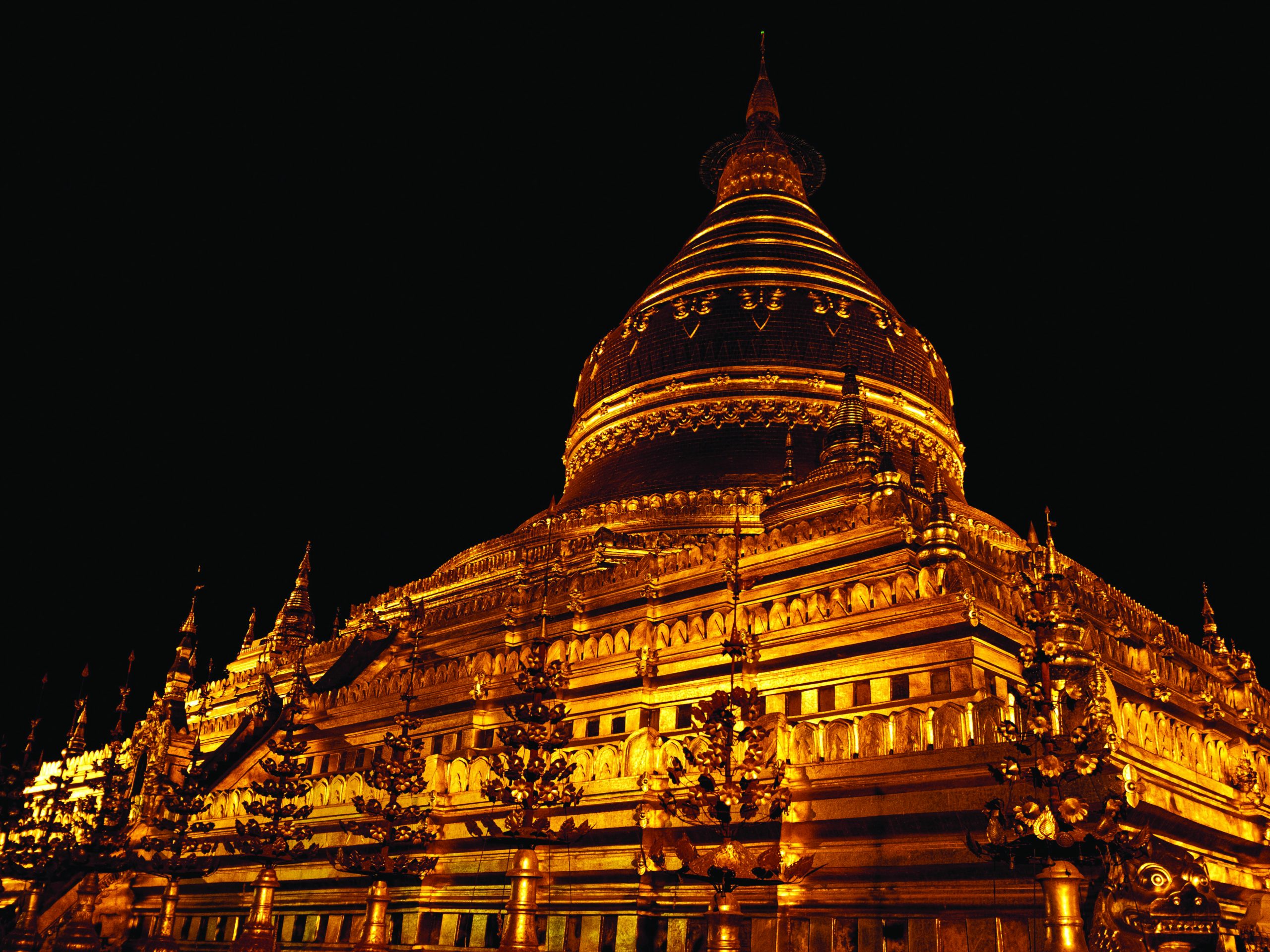
Accommodation. Top-end: Bagan HMWE Hotel (Rs.20,211 per night), Royal House Resort (Rs.4,875), Su Tine San Royal Palace Hotel (Rs.7,237). Mid-range: Yun Myo Thu Hotel (Rs.2,667), Bagan Comfort Hotel (Rs.4,328), Manisanda Hotel (Rs.3,769). Budget: Maya Bagan (Rs.1,901), Heritage Bagan Hotel (Rs.3,248), Arthawka Hotel (Rs.2,514).
Other destinations
Shan State. The largest state of the country, Shan covers nearly a quarter of Myanmar’s land area. Its most famous exhibits are the Leg Rowers of Inle Lake, the Floating Markets and Gardens, its Long Necked Women, the Shan shoulder bag and the longyi, Myanmar’s national dress.
The hilly Shan plateau borders China to the north, Laos to the east, and Thailand to the south and includes five administrative divisions of Myanmar. Representing a true slice of the country’s distinctive culture and diverse ethnicity, Shan offers unique attractions: the famous Inle Lake where the Intha people live in floating villages; Nyaung Shwe plain, the second largest natural expanse of water in Myanmar, shallow but 14 miles long and 7 miles wide; the vast limestone Pindaya Caves, which contain 6,226 Buddha images. These are not-to-be missed sights of Shan state.
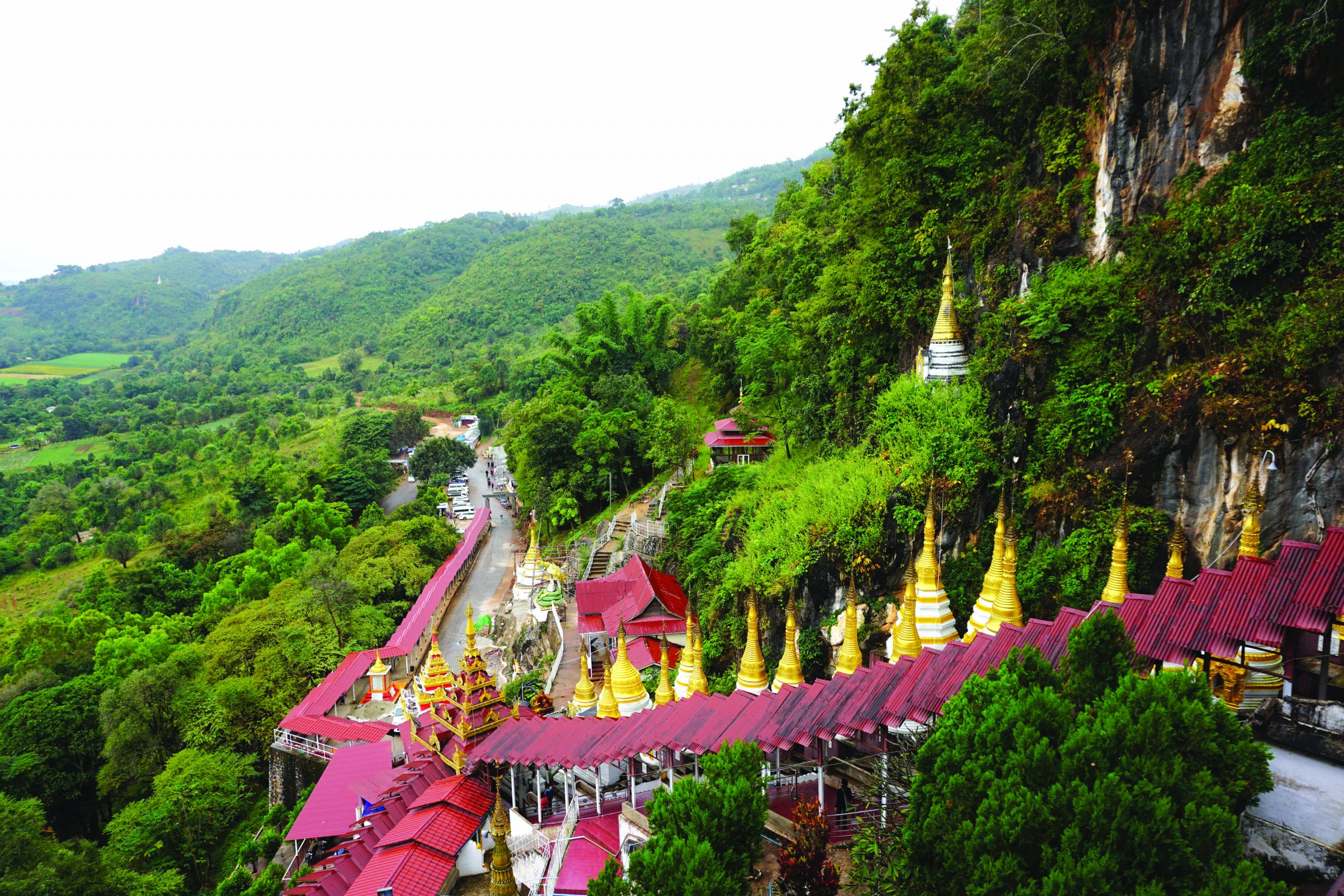
The View of pagodas and temples on the hill side at Pindaya cave Myanmar
Bago, formerly known as Pegu, is the capital of Bago division. Sited 70 km from Yangon, its most notable attraction is the Shwethalyaung Buddha, a 180 ft. recumbent Buddha, the second largest reclining statue of the philosopher sage in the world, after the 266 ft. Buddha in Dawei (Tavoy).
Built in 994 AD, during the reign of Mon King Migadepa, it was lost in 1757 when the district was pillaged. However, the Shwethalyaung Buddha was rediscovered in 1880 and partially restored in 1881.
Pathein (Bassein). Located in the Ayeyarwady delta about 190 km west of Yangon, this port city is noted for its handicrafts and the Shwemokhtaw Pagoda. To visit, catch the overnight ferry from Yangon, travel down the Twante Canal and through the delta waterways. It’s a scenic journey in a country where inland water transport is a major logistics option.
Thaton. Long before the rise of Bagan, a Mon kingdom thrived here. Today little remains of the ancient city other than traces of massive walls and some charming pagodas. The town’s core is a leafy area situated on either side of the highway, with a pleasing mix of colonial mansions and thatched-roof homes. A picturesque canal network irrigates rice fields and fruit orchards. Thaton is well connected by road and rail.
Pyay (Prome). Close to the ruins of the ancient Pyu capital of Thayekhittaya (Sri Kshetra) is this remote district, with its pagodas, crumbling walls, quaint railway station and small museum. Pyay has been the centre of intensive archaeological work carried out in Myanmar recently. The nearby Gautama Hill contains numerous Buddha images in niches.
Festivals. While visiting a country so richly endowed with a distinctive ethnic culture and traditions, it’s advisable to coincide your holiday with some of its colourful festivals. Among them: Full Moon Day of Tabaung (March), Water Festival and Myanmar New Year (April); Buddhist Lent (July-August) and Light Festival (November). The annual Phaung Daw Oo Pagoda Festival on the shores of Lake Inle creates a fairy tale ambience in the villages of Shan.






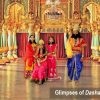










Add comment